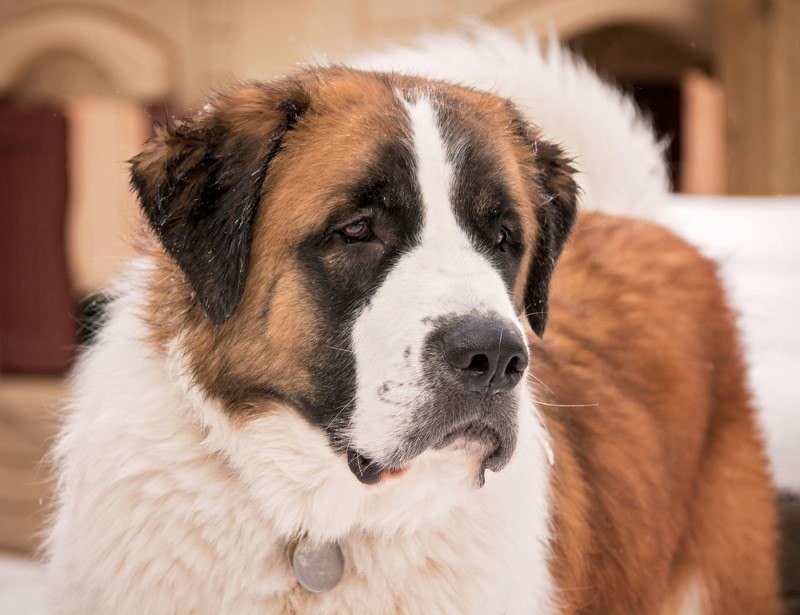When you think of gentle giant dog breeds, St. Bernards will always make the list. These excessively floofy, loveable, family-oriented goofballs are easy to spot due to their giant size and recognizable looks, and even easier to love. When considering a giant breed like St. Bernards, it’s important to be prepared for some of their most common health issues due to the cost of treating dogs of their size and their unfortunately shorter-than-average lifespans.
We’ve collected a list of these common health conditions so you can better understand their needs.

The 10 Main St. Bernard Health Issues
1. Hip Dysplasia
This genetic orthopedic condition is characterized by degeneration of a dog’s hip joints, causing significant pain, loss of mobility, luxations and subluxations of the joints, and secondary joint problems in the limbs.
Hip dysplasia should be screened for in all young St. Bernards, and when choosing a puppy from a breeder, their history should include information on any hip dysplasia in their line.
When a St. Bernard has hip dysplasia, in most cases, one of several surgical options will be recommended based on severity and finances, as well as lifelong joint support supplements and medications.

2. Elbow Dysplasia
Elbow dysplasia, hip dysplasia’s cousin, is also prevalent in St. Bernards. It is similarly inheritable, characterized by degeneration of the joint, but is caused by a collection of abnormalities in the elbow that lead to significant pain and loss of ability to use the joint.
St. Bernards with elbow dysplasia would need surgery to make the joint more comfortable, along with supportive supplements and medications, just like with hip dysplasia.
As both conditions are inheritable, St. Bernards with either should not be bred.

3. Wobbler Syndrome
Wobbler syndrome, also known as cervical vertebral instability or spondylomyelopathy, is a condition in which a dog has one or more of a collection of abnormalities associated with the spine, especially in the neck region. These abnormalities cause compression and stretching of the spine, along with arthritic changes that cause progressive pain, weakness, paralysis, and more.
Surgery to stabilize the spinal column is usually required, as are anti-inflammatory medications and physical therapy. St. Bernards that receive treatment early enough in the disease progression, especially if they can undergo surgery, have a good prognosis.

4. Osteochondrosis
Full name osteochondritis or osteochondrosis dissecans, this orthopedic disorder involves the incomplete development of parts of the cartilage in various joints as a dog matures. There are areas of cartilage that are supposed to thicken into bone as a dog ages, and with this condition, that can fail to happen. This thick cartilage has little blood supply and will eventually die and risk breaking or peeling off from the underlying bone, leaving cartilage fragments inside the joint.
These lesions can be very painful and lead to significant inflammation and arthritis in the joint or even complete degeneration of the joint.
The exact causes of this aren’t always known though there is a genetic component that predisposes St. Bernards to this issue. This can occur in almost any joint but is most common in the shoulder joint.
Radiographs are the classic way to diagnose this disorder though arthroscopy is also a good option when available.
Surgery or arthroscopy are the best ways to treat this condition in most cases, though if caught early enough, while still mild enough, medical management is also an option.
Seek veterinary advice if you’re concerned about your pet’s well-being.
5. Panosteitis
Young St. Bernards may develop a condition called panosteitis. It’s most common in young, large, fast-growing dogs and involves painful inflammation of the long bones of the dog. Sometimes referred to as growing pains, the signs can wax and wane and change limbs. Rest and anti-inflammatory pain medications do a great job of treating this condition when it occurs.
While there seems to be a likely genetic component to this disease, the exact cause is unknown, and the most important preventative measure that we know of for now is to make sure giant breed puppies such as St. Bernards are eating an appropriate diet with an AAFCO statement for a dog of their size and growth stage.

6. Cranial Cruciate Ligament Injuries
A dog’s knee joint has two crossing, stabilizing ligaments, of which the cranial cruciate ligament is one. Large dogs like St. Bernards are at higher risk of partially or completely tearing this ligament when running or jumping.
Depending on the dog, age, and tear, treatment can be medical or surgical. The best way to prevent a cranial cruciate ligament tear is to maintain a lean weight for your St. Bernard along with regular exercise. Using joint supplements throughout their lifetime is also a good idea.
7. Gastric Dilatation and Volvulus (GDV)
GDV is prevalent among large or giant breed dogs with deep chests, such as the St. Bernard. In these dogs, bloating of the stomach, typically after meals, can cause the stomach to twist around on itself, cutting off the blood supply and blocking stomach outflow. As the stomach rapidly expands, other organs can get pulled along and hurt, and major blood vessels for the rest of the body can be compressed too.
GDV is an emergency with a very real risk of fatality, even if treated promptly. It is recommended that all St. Bernards receive a gastropexy at about six months of age, in which the stomach is tacked surgically to the side of the abdominal wall to prevent twisting during periods of bloat, which can keep them safe from fatal complications. Other risk factors to monitor are exercise after meals, large meals, stress or anxiety, drastic temperature changes, and possibly which type of food is offered, though definitive answers about the best diet choice to avoid GDV are still undergoing research.

8. Entropion
Entropion is a problem seen in dogs with loose skin around their face, which includes St. Bernards. These skin folds that make St. Bernards so cute can leave them at risk of having their eyelids roll inwards, allowing their eyelashes to rub directly against the eye, causing pain and inflammation. In untreated cases, this can cause ulcers to the surface of the eye that can even affect vision or risk eye globe rupture if too chronic or left untreated for too long.
Luckily, treatment is generally pretty simple. Surgery to align the eyelid correctly is straightforward though multiple procedures may be needed as the dog changes in size.
9. Dilated Cardiomyopathy (DCM)
Some larger breed dogs, such as St. Bernards, are at higher risk of this form of heart disease. The heart enlarges over time as the walls thin and stretch until it fails entirely.
This is generally a genetic condition in St. Bernards though there is ongoing research potentially linking this condition with a dog’s diet in some cases.
St. Bernards diagnosed with DCM need to take heart medication to slow the progression of the disease, but unfortunately, most dogs can only live for up to two years after diagnosis on average.
10. Cancer
St. Bernards, like many other giant breed dogs, are prone to many cancers as they age. They have an increased risk of osteosarcoma and lymphoma, though there are many other potential types too.
Cancers like osteosarcoma and lymphoma can be treated in the short term but cannot be cured, though other cancers that a St. Bernard may develop might be. Annual physical exams and screening lab work are important for monitoring for signs of cancer in St. Bernards, even from a young age.


Conclusion
Most conditions that St. Bernards are prone to are also common across other large and giant breed dogs. Careful research into a St. Bernard’s lineage, along with prophylactic surgery like a gastropexy, can significantly lower the chances of developing many of these conditions. Keeping a St. Bernard a lean weight is also very important as most of these other conditions are more likely if they are overweight. If getting a St. Bernard puppy, regardless of their known genetic history, be sure they undergo hip testing for hip dysplasia and continue to watch for any of these common health issues.
Featured Image Credit: Zoran Photographer, Shutterstock



















